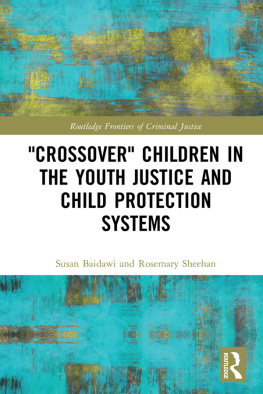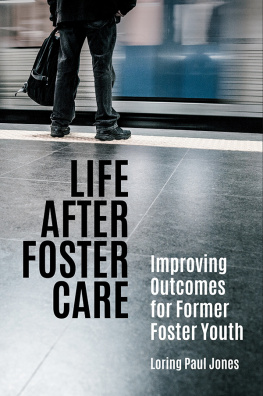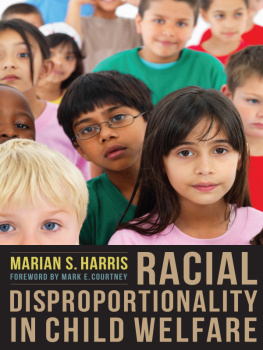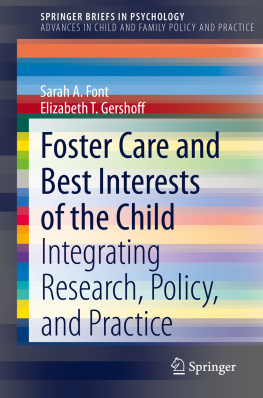ACHIEVING PERMANENCE
FOR OLDER CHILDREN
AND YOUTH IN FOSTER CARE
Achieving Permanence for Older Children and Youth in Foster Care
Edited by
Benjamin Kerman, Madelyn Freundlich, and Anthony N. Maluccio |
COLUMBIA UNIVERSITY PRESS  New York
New York
Columbia University Press
Publishers Since 1893
New York Chichester, West Sussex
cup.columbia.edu
Copyright 2009 Columbia University Press
All rights reserved
E-ISBN 978-0-231-51932-8
Library Of Congress Cataloging-in-Publication Data
Achieving permanence for older children and youth in foster care / edited by
Benjamin Kerman, Madelyn Freundlich, and Anthony M. Maluccio.
p. cm.
Includes Bibliographical References and index.
ISBN 978-0-231-14688-3 (cloth : alk. paper) ISBN 978-0-231-14689-0
(pbk. : alk. paper) ISBN 978-0-231-51932-8 (ebook)
1. Foster childrenUnited States. 2. Foster home careUnited States.
I. Kerman, Benjamin. II. Freundlich, Madelyn. III. Maluccio, Anthony N. IV. Title.
Hv881.A62 2009
362.73'30973dc22
2008054450
A Columbia University Press E-book.
CUP would be pleased to hear about your reading experience with this e-book at .
References to Internet Web sites (URLs) were accurate at the time of writing. Neither the author nor Columbia University Press is responsible for URLs that may have expired or changed since the manuscript was prepared.
In april 2005, the organizers of the fourth National Convening on Youth Permanency facilitated a discussion among researchers concerning the state of research about permanency services to promote family relationships and connections and the needs of older youth served by the child welfare system. A general consensus emerged that there is a troubling lack of systematic empirical insight into the dynamics of the child welfare population, the needs of older youth, the impact of policy and the effectiveness of the services provided, and even the definition of youth permanency. it also became apparent that, while a variety of investigators might be working to address these shortcomings in the research base, their individual efforts were disparate, too insular, and often unknown to one another.
Planners of the fifth National Convening quickly recognized this need with a sense of urgency, initiating the development of a research roundtable to coincide with the meeting in September 2006. With input from Rosemary Avery and Ruth McRoy, Anthony Maluccio and Benjamin Kerman designed a format of presentation and discussion and assembled a diverse group of researchers well positioned to summarize the state of research on the needs and outcomes for older youth involved in child welfare, as well as research on policy and practice initiatives to address these concerns. The invited panelists responded enthusiastically, eagerly engaging in their respective tasks as reviewers, presenters, respondents, and authors. We deeply appreciate the panelists commitment to the children and families served in child welfare, made abundantly manifest in their contributions to this volume.
We also greatly appreciate the generous support provided to the participants in the Research Roundtable by the Annie E. Casey Foundation and its direct services agency, Casey Family Services. At the same time, it should be noted that all opinions expressed in this volume are those of the respective authors and do not necessarily reflect the positions of the funders or our home institutions.
This volume would not have made it to paper without the essential and able logistical and clerical assistance of Sharon Pitman and Pamela Harrison. Ms. Pitman's ever-present common sense often came in handy in the face of momentary shortages. Other Casey Family Services colleagues contributed in myriad ways to make the roundtable and editing enterprise a success: Raymond Torres, Joy Duva, Sarah Greenblatt, Lee Mullane, and Lauren Frey, as well as Gretta Cushing, Ellen Ross, and Karen Jointer. Like-wise, Columbia University Press's Lauren Dockett has been steadfast and patient in her support, enabling this work to make it to the done section of our to-do list.
While the volume would be literally empty without the contributions of our professional colleagues, our understanding of the true meaning and impact of family connections would be hollow had we not benefited so deeply from two groups of families. We are humbled before the collective commitment, guidance, wisdom, perseverance, and example personified by the families with whom we have had the honor of working and learning over the years. Finally, we are each most permanently indebted to the abiding and sustaining connections with our own familiesour parents, spouses, children, and grandchildren. Their day-to-day patience, and weekly willingness to share our burdens and joys, juxtaposed alongside our life-long connections, provides permanence's greatest tribute and most compelling evidence.
Older children and youth in recent years have come to comprise an increasingly larger proportion of the foster care population in the United States. Their needs differ in significant ways from those of younger children for whom permanency has long been a primary goal. Traditionally, child welfare systems have focused on preparing older children and youth for adulthoodwith far less attention directed to efforts to reunify them with their birth families, find new families for them through adoption or guardianship, or help them forge lifelong connections with caring, committed adults who will be there for them as they transition to the adult world and beyond. although permanency planning is certainly not new to those familiar with foster care, efforts to achieve enduring connections to families for older children and youth too often have been sacrificed in the service of concentrating on preparation for independent living.
In this volume, we explore the challenges that child welfare systems confront in meeting the permanency needs of older children and youth in foster care. We examine the potentially conflicting goals that can lead to the development of policies and practices that fail to support efforts to achieve and sustain enduring family relationships, and we propose practice and policy approaches that can guide effective permanency work with these children and youth. We recognize that although states are charged with acting in loco parentis when children and youth enter foster care, bureaucracies cannot provide them with the nurturing, guidance, cheerleading, safety net in times of trouble, and ongoing supports into adulthood that good parents provide.
The volume is based on a belief that child welfare systems will better serve children and youth by redefining their role, changing it from substitute parenting to ensuring that children and youth are connected to safe, nurturing, and forever families. With a commitment to achieving and sustaining family permanence for these youth, child welfare agencies can ensure that when they leave care and their cases are closed, they will have the benefit of caring, supportive families that young people require as they move into adulthood and beyond.
PERMANENCE AND LIFELONG FAMILY CONNECTIONS
From both a practice and a legal perspective, family-based permanence is the preferred outcome for children and youth in foster care. Families provide them not only with shelter and financial supports but also with a set of relationships with consistent and supportive adults that are intended to last indefinitelyindividuals to whom a child can return for support even as an adult. For these young persons, permanence means lifelong family connections and can take a variety of forms: reunification with parents; permanent placement with relatives; guardianship with relatives or other committed adults; adoption; or, when legal permanence is not possible, life-long connections with caring adults who, though not in a legal relationship, are committed to the child into adulthood. The objective of achieving permanence is to reach the optimal balance of physical, emotional/relational, legal, and cultural dimension within every child's and youth's array of family relationships.
Next page






 New York
New York